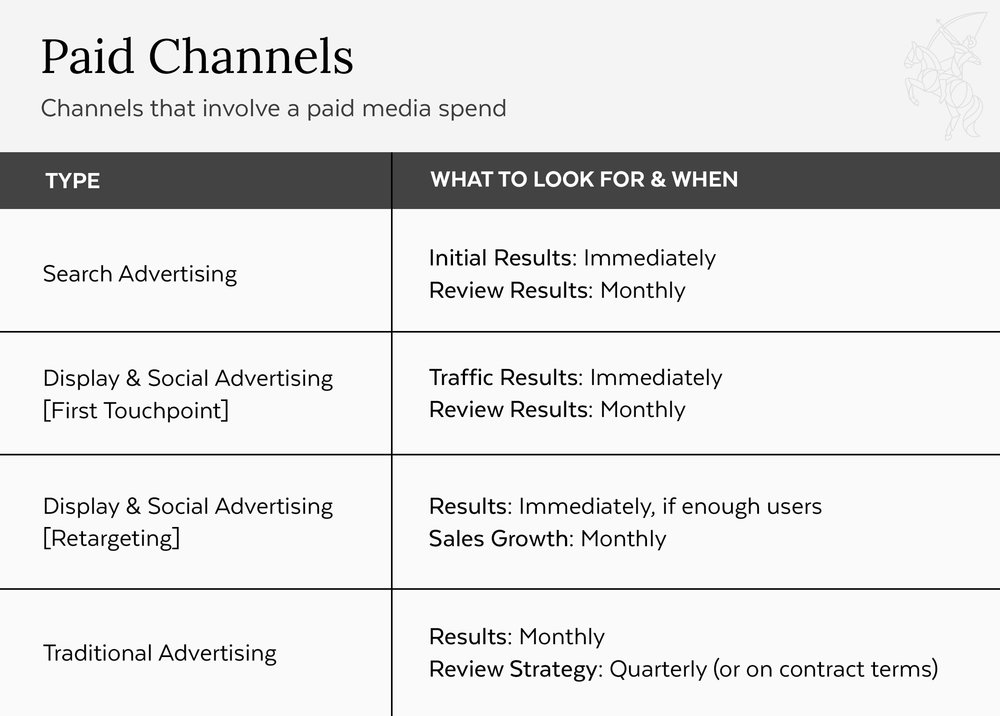When You Can Expect Results From Different Ad Efforts
Whether you’re an SEO specialist, a broadcast media buyer, or anything in between in the world of advertising, you’ve probably heard this question too many times to count:
When can we expect to see results?
As simple as that seven-word question may seem to the uninitiated, the answer can be so complex that we’ve decided to dedicate a blog to it! The one sentence answer to this question is that it depends on too many unique factors to give a definitive timetable. Believe it or not, that rarely satisfies clients, so we’d like to break down how you should set your expectations by individual channel.
While these numbers are certainly not definitive, they are a good baseline for anyone working in advertising & digital marketing, especially at a small agency.
Organic Channels
For the purposes of separating different channel types, we’re dividing them between Organic Channels and Paid Channels. We’ll be starting with Organic Channels, which we’re loosely defining as channels that don’t involve a paid media spend. If you’re a business, this doesn’t mean they cost nothing, you’ll still be paying an agency or an internal employee to carry out these services, but you aren’t also paying for media space.
What all these efforts have in common is that they are long-term plays. Rather than looking for immediate wins, you should be looking at trends.

SEARCH ENGINE OPTIMIZATION
See Results in 4 to 6 Months, Look at Annual Trends
Out of all 7 types of advertising we’ll discuss today, SEO may be the most complicated and most difficult to quantify. Your immediate & long-term results following a new SEO strategy will be very different depending on your website’s age, previous SEO metrics like traffic & keyword ranking, the age of your business, and how many indexed pages you presently have. For example, a 10-year-old website with 100 optimized pages and a nation-wide SEO strategy won’t see the immediate growth of a brand new website with a dozen pages that’s only focusing on local SEO rankings.
Speaking generally, you shouldn’t expect to see results sooner than 4-6 months. That said, SEO growth snowballs in your favor. You’ll see faster growth at 12 months than you will at 6 months. We suggest clients look at SEO in quarterly increments and focus on year-over-year trends.
CONTENT GENERATION
See Strategy Results in 4 to 6 months, Individual Post Results Within a Month
Generating new content, whether onsite or offsite, is an extension of any SEO strategy. As such, the expectations are similar to that of SEO for your content generation plan. You can, however, evaluate new pieces of content individually in under a month. Good content should directly correspond to real questions your targeted users are asking. If your new content successfully answers users’ questions, you should see traffic to your content piece as soon as Google indexes it.
SOCIAL CHANNEL POSTING
See Follower Growth Monthly, Sales Growth Quarter-Over-Quarter
What we’re talking about here is specifically posting to your social media platforms. Think Facebook status updates or Instagram posts, not paid advertising. Just like SEO, there are a lot of variables to consider here, like how long you’ve been executing your social strategy, how well known your brand is, and how many followers you have.
Unlike SEO, where keyword ranking, traffic, and conversions are universal indicators of success, with social posting you need to definite what success looks like for you. Is it generating more followers? Well, you can check in on that daily and look at results on a monthly basis. If you’re looking to turn social follows into sales or repeat customers, that’s a bit more complicated. We talk about traffic from social media on a monthly basis with our clients but always keep it within the context of their following.
Paid Channels
Unlike the Organic Channels above, all of our Paid Channels involve an actual media spend. That can range from paying a few cents for an AdWords click up to paying tens of thousands for a broadcast television spot. No matter what, the consistent theme here is that we’re more focused on quick wins, and with the paid spend we can typically tie a conversion to a hard cost to see whether or not we’re profitable.

SEARCH ADVERTISING
See Initial Results After Day One, Review Monthly
The beauty of advertising through AdWords is that you’re going to see results the first day. After your first daily budget is spent, you’ll be able to review your click-through-rate, the search terms that led to clicks, which ads performed best, and much more. We definitely do not encourage clients to decide whether AdWords is a viable avenue after one day, but you do get a sense of what to expect after day one.
If your key results metric is sales, you’ll have to wait just a bit longer. Especially in cases where your brand is service-oriented, has little brand recognition, or sells an expensive product; encourage you to look at sales on a monthly basis. In these cases, AdWords will likely be their first touch point ever with the brand, and it will likely take more interactions before your AdWords user pulls the trigger.
We typically review campaign health, conversions, and how qualified users are on a monthly basis, which ensures a large enough sample size and allows us to cleanly compare month-over-month AdWords data alongside month-over-month SEO data.
DISPLAY & SOCIAL ADVERTISING [FIRST TOUCHPOINT]
See Traffic Results Immediately
If you’re using display & social advertising to create brand awareness or an initial touchpoint with qualified users, you’ll see the fruit of those efforts almost immediately in terms of site traffic. Whether you’re using Google’s Display Network, the Facebook/Instagram dashboard, or any other display partner, you’ll have access to robust analytics chronicling how many people you’ve reached, what action they took, and how qualified they are as soon as you hit go.
When doing this sort of brand awareness advertising, we don’t encourage clients to view sales as the be-all-end-all metric, which brings us to:
DISPLAY & SOCIAL ADVERTISING [RETARGETING]
See Results Immediately If There Are Enough Users, See Sales Results Monthly
Retargeting, or as clients lovingly call it “the creepy ads,” is where display & social advertising meet sales. These ads are exclusively served to individuals who have taken a predetermined action with your brand. Typical examples include viewing a product, abandoning their cart, or even just clicking on a previous ad.
Similar to brand awareness display advertising, you can theoretically see results after day one, but the population you’re advertising to has to be created first. If you’ve only been tagging users on your site to be retargeted for a day or so, you may only have a dozen users in this group. Compare this to retargeting after 6 months of user collection, wherein you could have thousands of users in this group.
It may take seeing ads multiple times over the course of a month to finally make a purchase, but we generally encourage clients to look at sales from retargeting campaigns on a monthly basis.
TRADITIONAL ADVERTISING
See Results Monthly, Review Strategy Quarterly (Or Based On Contract Terms)
Unlike the above efforts which are exclusively digital, traditional advertising efforts like billboards, tv, and radio are quite a bitter harder to quantify. If you’re sending traffic from traditional ad efforts through your website, you’ll need to use unique URLs only used in these ads and review overall traffic on a month-by-month basis.
Unless you’re using a digital coupon code of some kind, attaching ROI to traditional advertising can be extremely difficult, which is where looking at overall sales trends becomes important. We recommend clients look at this data after the first month of a traditional ad engagement, and review strategy after a sales quarter or as they near the end of their media spend timeline.
We hope this overview helped you understand exactly what to expect from your advertising and marketing efforts. If you’re an agency professional, our best piece of advice is that clients don’t care all that much about when they can expect to see results. What they care about, and what you should take great care to do, is having their expectations set properly. We have never had any client be disappointed when their sales didn’t spike after month one because we’ve never let a client have those expectations in the first place.
When we talk about starting with a client’s Why before we assign them a What, this is exactly what we’re talking about. With these channel results expectations in your back pocket, create a unique strategy around their unique needs. Don’t sell SEO to a client that needs quick wins, don’t sell a billboard to someone who wants qualified user growth over the next few months. And no matter what, set proper expectations.
